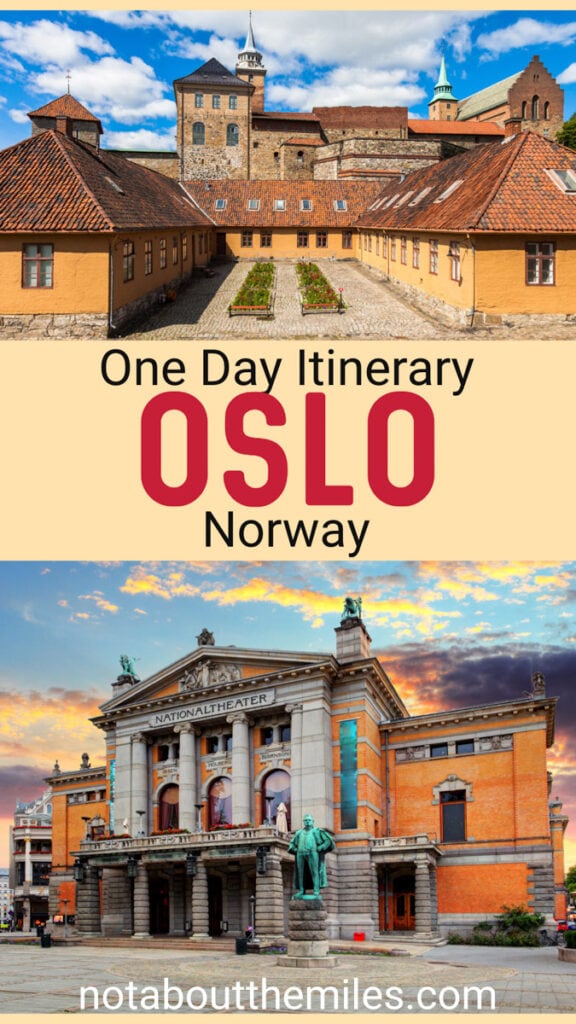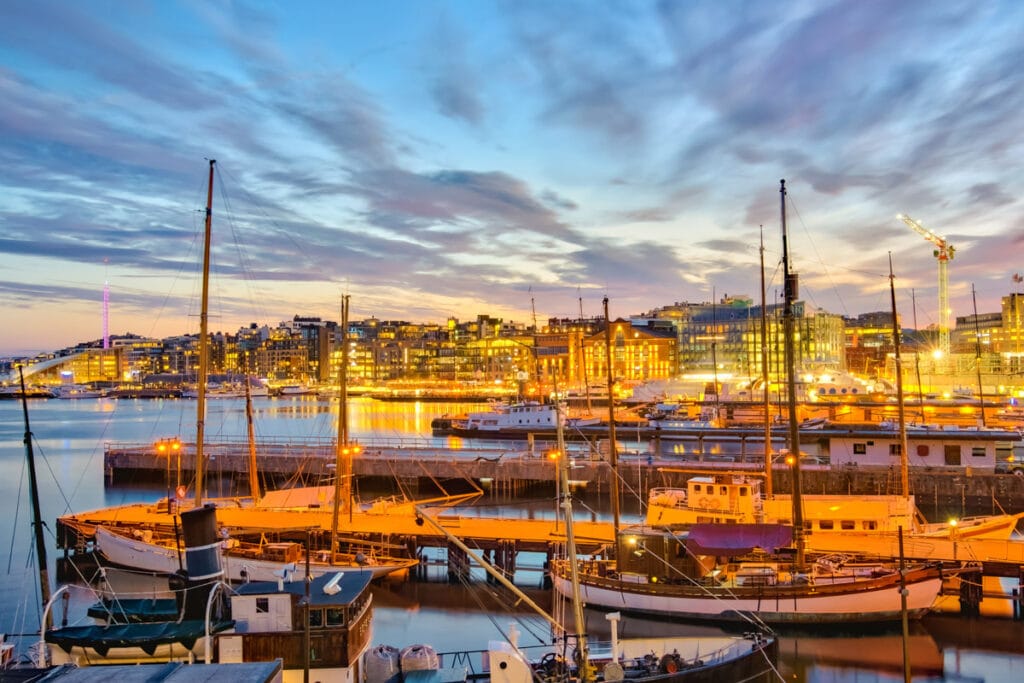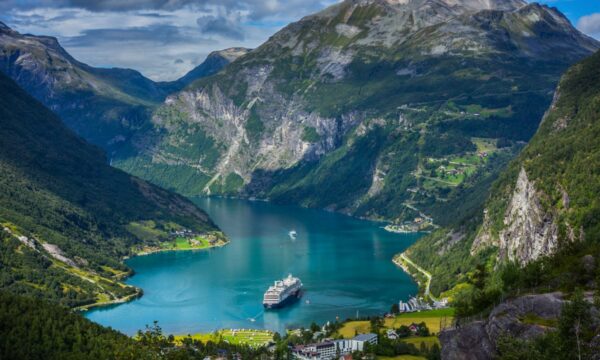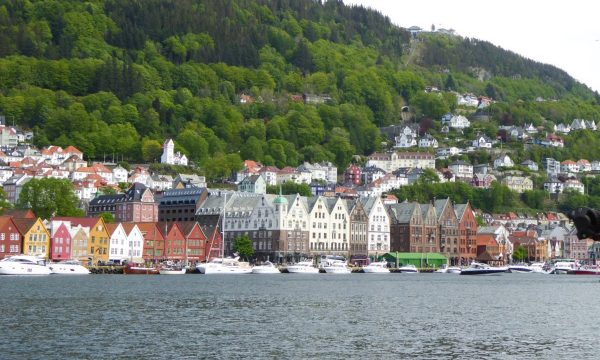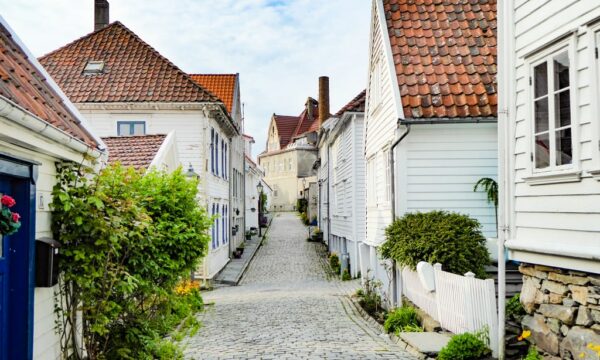Wondering how to spend one day in Oslo?
The Norwegian capital city of Oslo offers a mix of striking art and architecture, many topnotch museums, and a mellow but very cool vibe. Somewhat of an underrated destination in Scandinavia, Oslo is compact and walkable, making it easy to explore in one active day.
Located at the head of the scenic Oslo Fjord on Norway’s southern coast, Oslo is surrounded by forested hills on other sides.
While the city center boasts many beautiful buildings that make Oslo well worth visiting, it also has plenty of green spaces perfect for wandering, as well as the unique Vigeland Sculpture Park and a vibrant waterfront.

Some links on this page may be affiliate links. If you click an affiliate link and make a purchase, we may receive a small commission, at no extra cost to you. For more details, refer to our disclosure.
Oslo’s laid-back ambience is very appealing to travelers that want to relax and take in the sights and culture at an unhurried pace. And foodies will delight in the many quality restaurants where you can sample authentic Norwegian cuisine.
Ready to discover the Norwegian capital? Read on for the best things to see and do in Oslo in one day, plus our suggestions for where to stay and eat.
One Day in Oslo Itinerary
1. Admire the Vigeland Sculptures, Oslo’s Coolest Attraction
Start your one day in Oslo at the sprawling Frogner Park, the largest park in Central Oslo and a popular spot for local runners, dog walkers, and families.
The park is home to the country’s largest rose collection, with around 14,000 bushes. The garden looks spectacular when in bloom!
Originally, the park was part of the historic Frogner House, until the land was sold off. Then, in 1990, the government decided to create a park that the public could enjoy.
Frogner House is still located here but it’s now home to the Oslo City Museum.
Within Frogner Park, the star attraction is Vigelandsparken (also known as the Vigeland Sculpture Park). Attracting over a million visitors a year, the sculpture installation one of Norway’s most visited attractions.
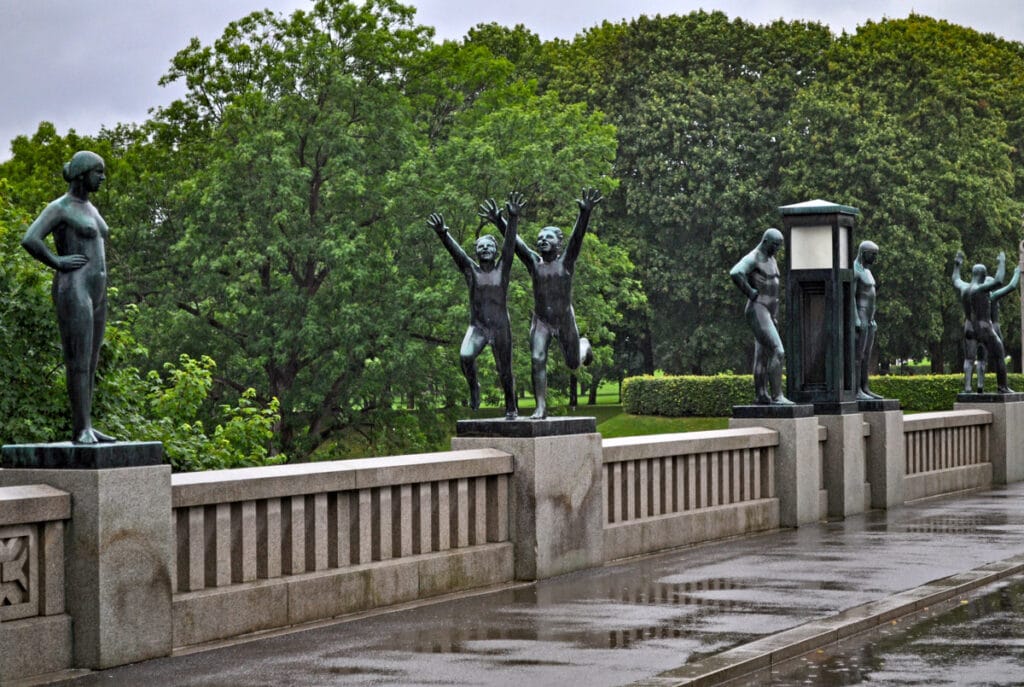
The installation includes over 200 sculptures, all of which were designed by Gustav Vigeland, a renowned (and prolific!) Norwegian sculptor.
Created from bronze, granite, or wrought iron, the unclothed human sculptures depict the human condition and the journey from the cradle to the grave.
Some of the most famous works at Vigelansparken include The Angry Boy, The Monolith, The Fountain, and The Wheel of Life.
You’ll find The Angry Boy on the bridge that connects the main gate with the stunning fountain in the park, along with several dozen other sculptures created by Vigeland.
The Monolith, carved out of a tall block of stone, features 121 intertwined human figures: men, women, and children all looking like they are climbing over one another to reach the top. The Monolith is the focal point of the park.
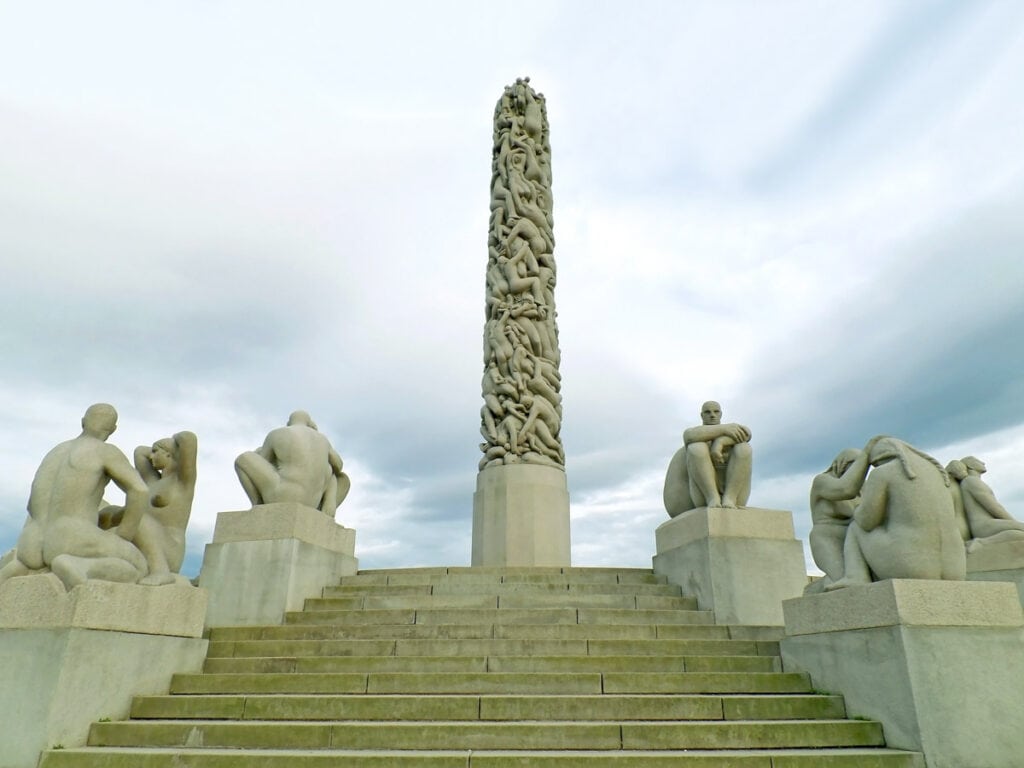
The Fountain is encircled by twenty statues representing the cycle of human life. The Wheel of Life is a circular garland of human figures, and represents the concept of eternity.
Wandering the sculpture park to gawk at the cool statues makes for a great start to your Oslo sightseeing.
The park is open 24 hours and is free to enter.
2. Tour the Royal Palace in Oslo
Although the foundation stone for the Royal Palace was laid in 1825, the building wasn’t officially occupied until 1849.
Built in a neoclassical style, this palace has had several residents throughout the years including King Oscar I and Charles IV. After much-needed restorations, the current king and queen moved back into the Royal Palace in 2001.
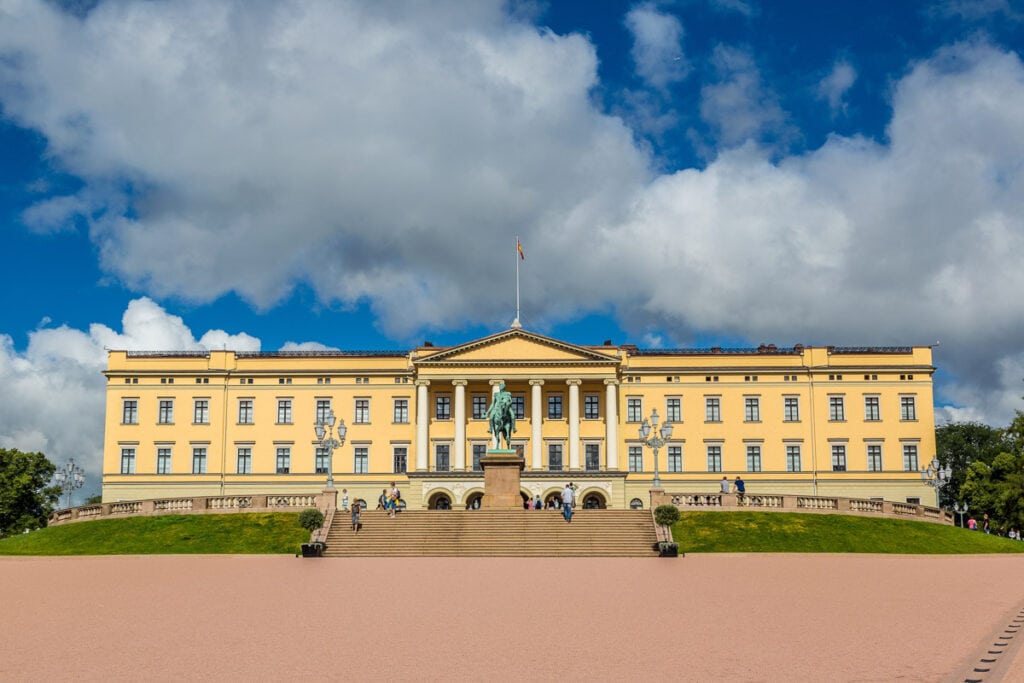
Interiors in the palace reflect multiple styles, and many notable artists of the time contributed to the decoration.
Surrounding the Royal Palace on all sides, you’ll find the beautifully landscaped gardens of the Palace Park, which make for a great stroll any time of the year.

In the summer, the interior of the Royal Palace is open to the public, and if you visit then, you can take a tour to see some of the main rooms, including the Council Chamber and the King Haakon VII Suite. Visit the palace website for operating hours and to buy tour tickets.
The Palace Park is open 24 hours and free to visit.
The Royal Palace is located at the end of Karl Johans Gate, which leads us nicely onto the next stop of this Oslo itinerary.
3. Stroll Karl Johans Gate
Strolling Karl Johans Gate is a must on your one day in Oslo!
As the main street in Oslo, Karl Johans Gate is home to lots of cafes and restaurants, designer retailers, and prominent buildings.
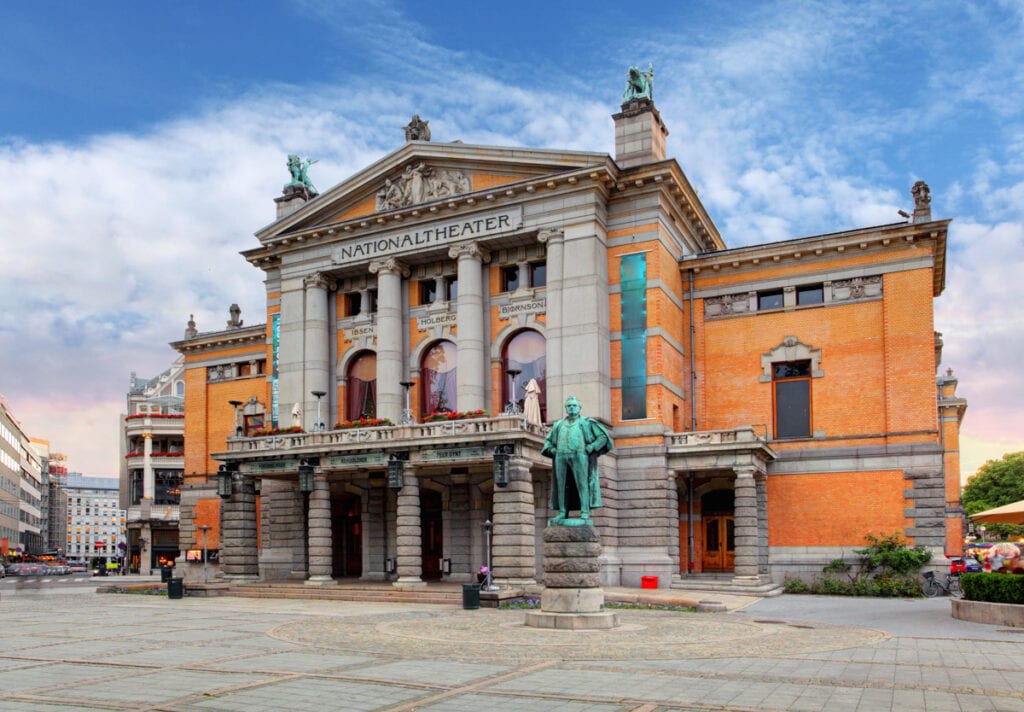
Stretching between the Royal Palace and Oslo Central Station, this bustling street is a must-visit whilst in the city. It’s named after King Karl III Johan. Over the years, extra sections of street were added to create this charming boulevard.
Stop to snap photos of Oslo’s National Theatre building, which dates back to 1899. It has a stunning facade, with statues of Henrik Ibsen and Bjørnstjerne Bjørnson, two of Norway’s greatest writers, guarding the main entrance.
Also along the street you’ll find the Norwegian Parliament building, Stortinget, which also has a majestic facade, with a striking semi-circular center with many arched windows. Its design is said to have drawn inspiration from great buildings in Italy and France.
Just west of the Parliament building is Eidsvolls plass, where you can admire the pretty pond. In the winter, it becomes a skating rink!
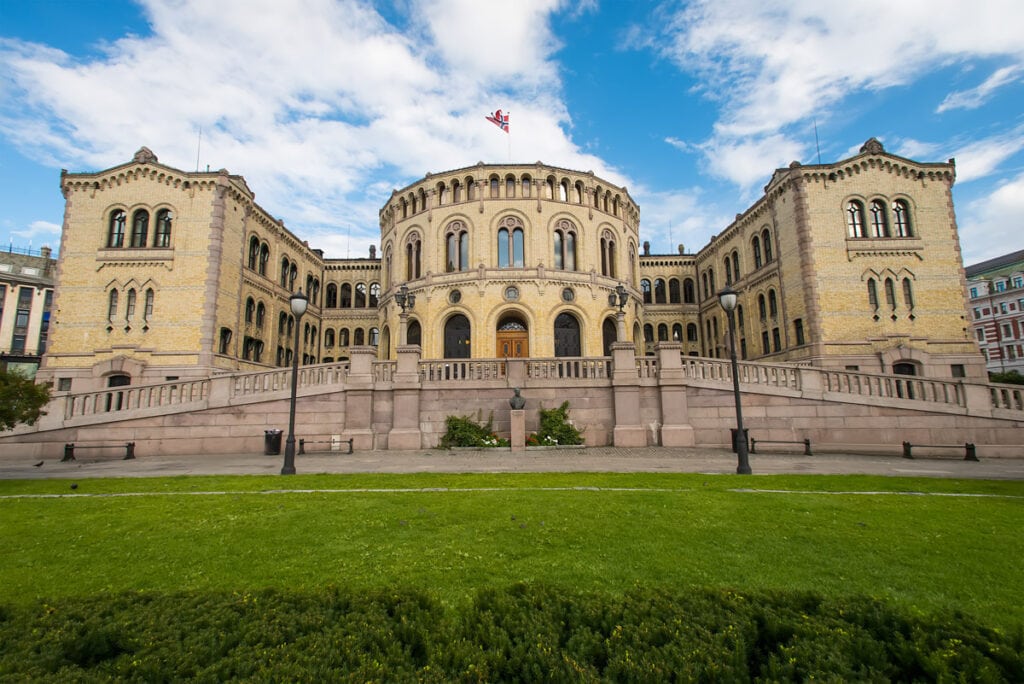
As you wander along this lively street, you can enjoy street performances, stop for a drink and a sweet treat at a quaint cafe, and admire the many historic buildings.
If you walk all the way to the Oslo Central Station, be sure to stop and snap a photo of The Tiger, the sculpture by Elena Engelsen.
One of the most photographed sculptures in Oslo, the bronze tiger sculpture was gifted to the city on its 1,000th anniversary. Oslo wanted a tiger, because its nickname is “The Tiger City.”
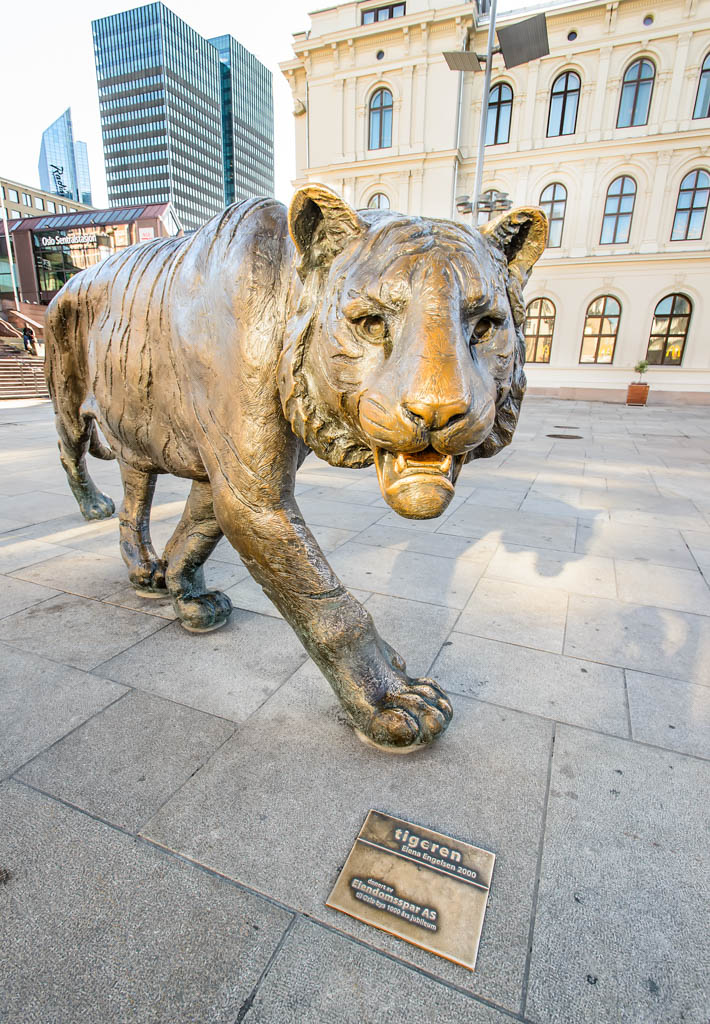
4. Get Your Art Fix at the National Museum
If you enjoy art, you’ll definitely want to stop by the National Museum, Norway’s largest art museum.
Much of the art here was housed in the National Gallery until 2022, when the ‘‘New National Museum’ was built. Today, the new museum is the largest in the entire Nordic region, and is home to around 6,500 art works in its permanent collection.
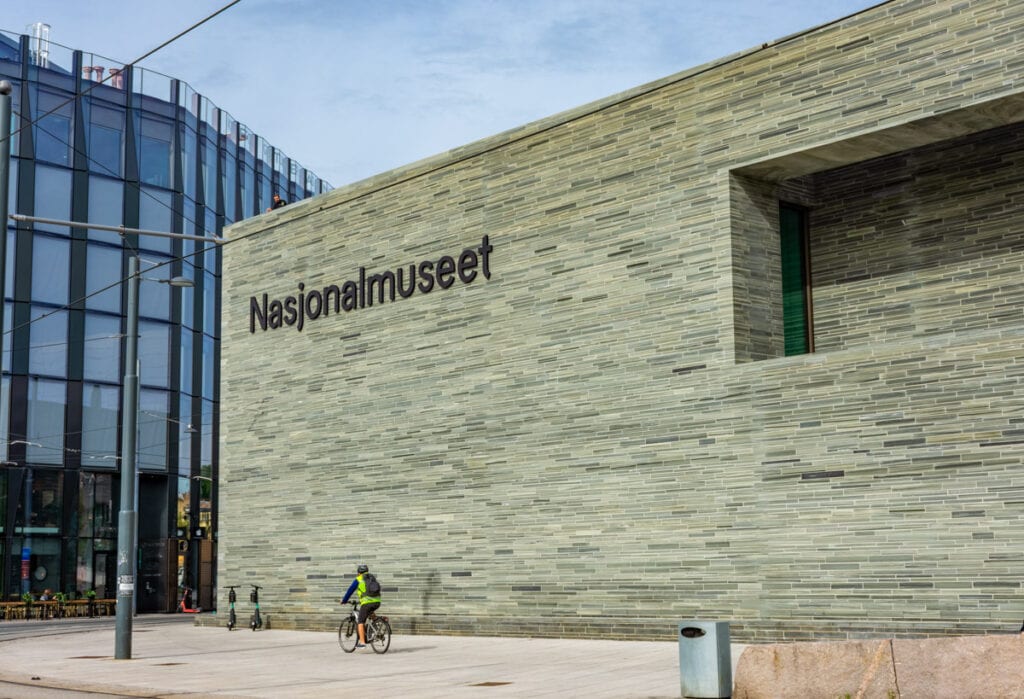
Art lovers will find a smorgasboard of art here, from traditional to modern and contemporary art (the permanent collections spans the period from antiquity to the present), as well as architecture and design exhibits.
Exhibits are displayed in over 80 rooms across two floors.
Don’t miss The Scream and Madonna, both by Edvard Munch, and the Baldishol Tapestry, almost 1,000 years old!
The permanent exhibition alone is enough reason to visit, but you’ll also want to check for any temporary exhibitions during your trip. Film screenings are often held here too!
If you get peckish, the bar on the rooftop terrace serves snacks and drinks. It also offers striking views of the inner Oslo Fjord!
The museum is open every day of the week except Monday. Check operating hours and buy timed-entry tickets here.
5. Take in the Views from the Oslo Opera House
You’ll definitely want to visit the Opera House on your one day in Oslo!
The first thing you’ll notice about this quirky building is its angular design, the cool white facade (granite + Carrara marble!) and its stunning setting, right by the Oslo Fjord.
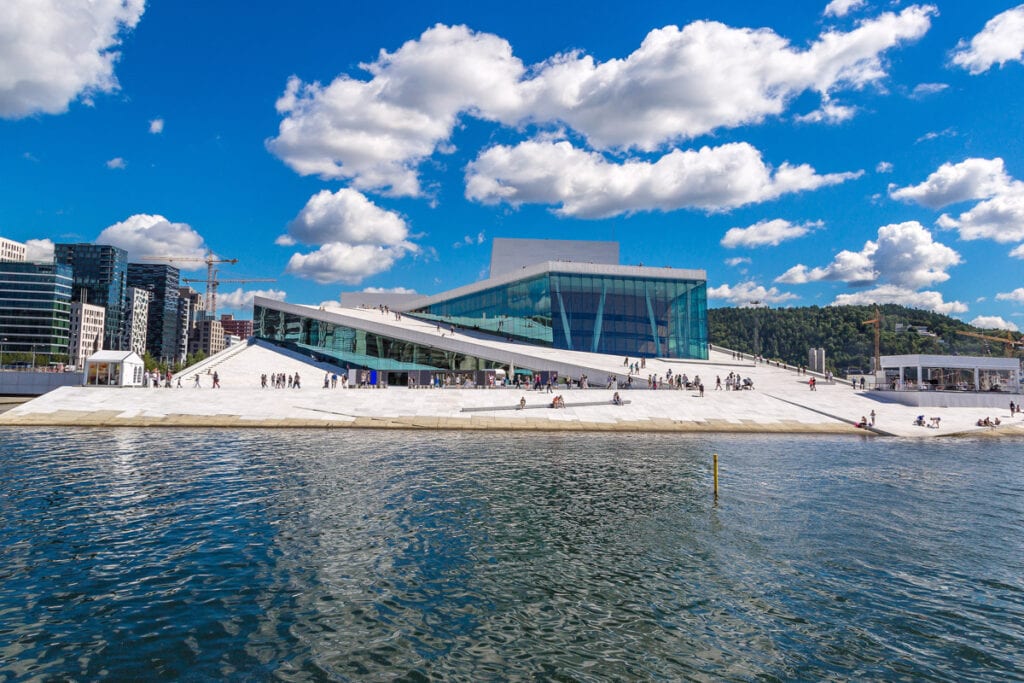
The coolest thing to do at Oslo’s Opera House is to walk its rooftop!
From here, you’ll be treated to breathtaking views of the city center, the fjord archipelago, and, in the distance, the hills and mountains surrounding Oslo.
The foyer is impressive, featuring super tall windows with minimal framing that let in spectacular views of the water.
The views alone are worth the visit, but you can also enjoy a guided tour of the opera house to learn about its history, architecture, and stage technology.
And you can also return in the evening if you like, to catch a performance here.
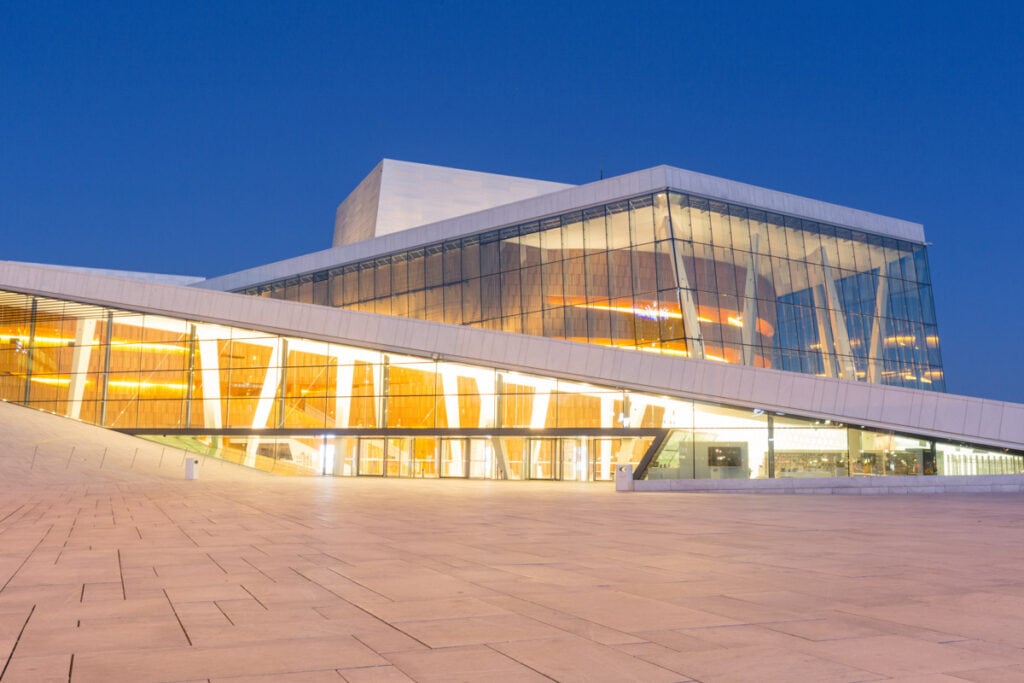
The Oslo Opera House is a relatively new building as it only opened in 2008, but it’s been host to some pretty impressive events through the years. Here, you can enjoy traditional ballet, opera, and concerts.
Guided tours are offered daily, in Norwegian and English, and entrance and the rooftop experience are free.
6. Tour the Norwegian Museum of Cultural History
Now it’s time to head over to the Bygdøy peninsula, where you’ll find many Oslo museums from which to choose. When it’s operating, generally between April and October, you can take the Bygdøyfergene, the “ferry to the museums,” from the City Hall Pier 3.
The Norwegian Museum of Cultural History (also known as Norsk Folkemuseum) is a must-visit, to learn about the people of Norway and how the locals have lived through the ages.
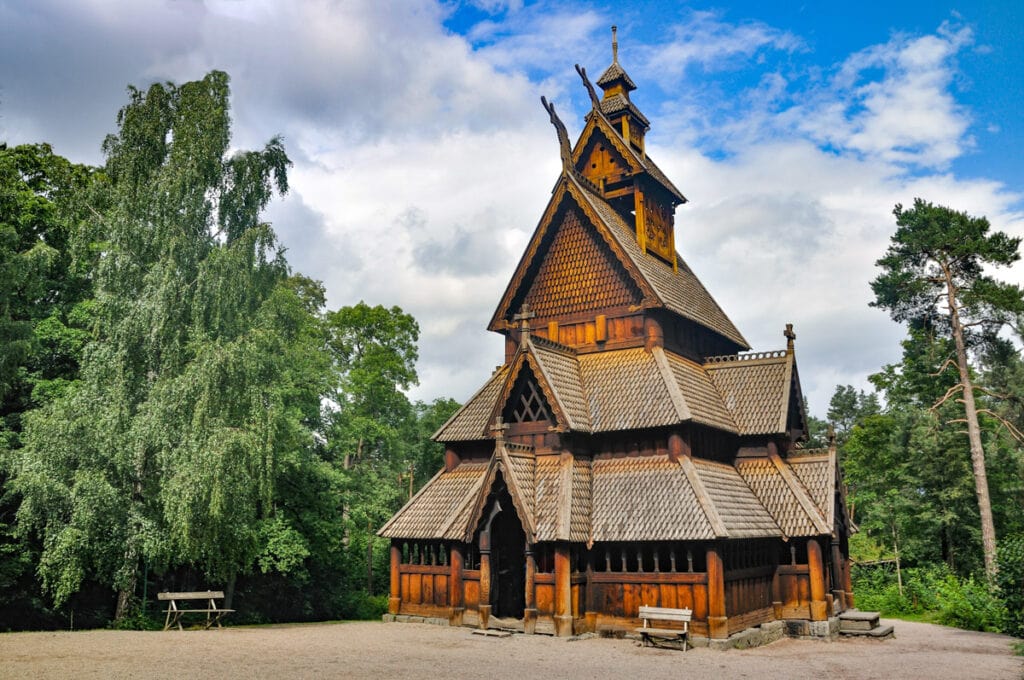
Established as early as 1894, this museum eventually came to be one of the largest open-air museums in the world.
The museum is home to over 160 historic buildings, some of which date back to the 1200s.
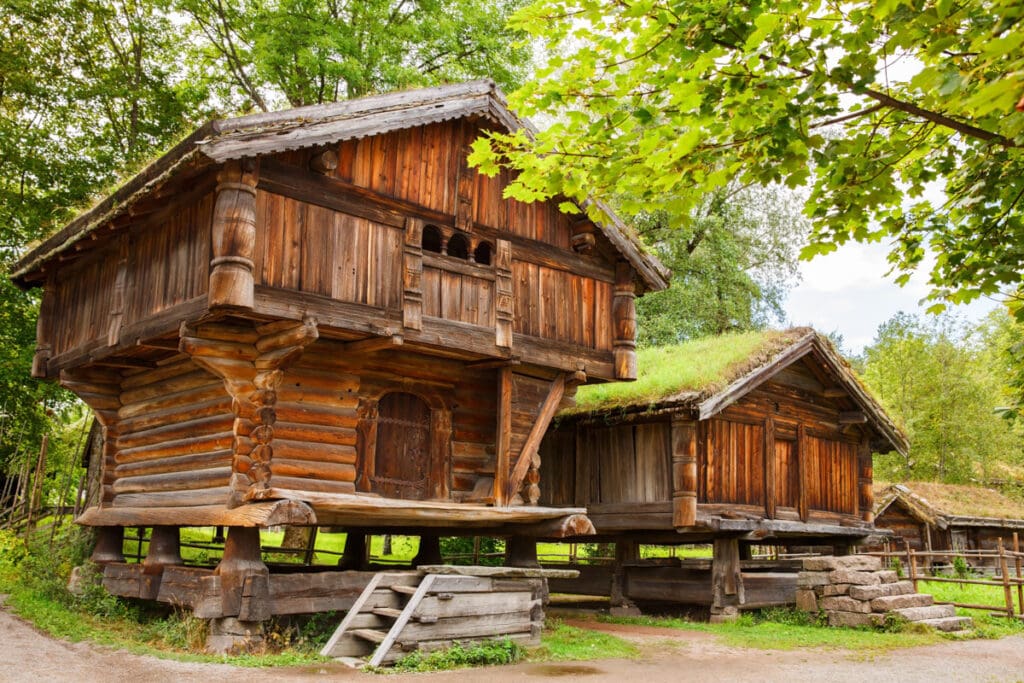
Don’t miss the Gol Stave Church, the Gate Saw and Fulling Mill, and the Old Town, which contains buildings from Oslo when it was known as Christiania, and its suburbs.
The great thing about Norsk Folkemuseum is that you’ll get to visit different areas of Norway without actually leaving the capital! As you wander around the museum, you’ll pass by several ‘regions,’ including Trøndelag, Finnmark, and Hardanger.
You’ll also find exhibition buildings here that host a variety of different events and exhibits.
The Norsk Folkemuseum is open everyday from May through September and Tuesday through Sunday from October through April. For current hours of operation and entrance fees, visit the museum website.
7. Visit the Viking Ship Museum
Also on the Bygdøy peninsula you’ll find the iconic Viking Ship Museum.
Since its opening in 1926, the museum has attracted millions of people from all across the world.
The museum is home to three of the best-preserved Viking ships on the planet: the Oseberg, the Gokstad, and the Tune. The ships were extracted from the Oslo Fjord and have been restored.
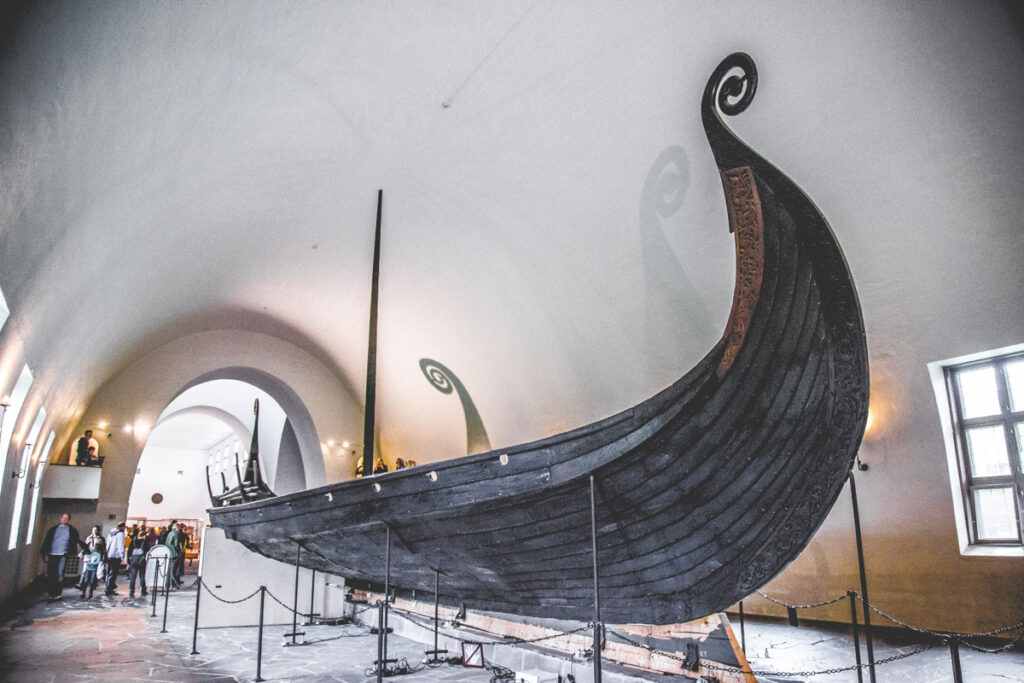
The Oseberg, extracted and exhibited in its entirety, is stunning!
The museum is also home to numerous artifacts from the Viking era, from sledges and carts to wood carvings and items of daily use.
Good to know: The Viking Museum is currently closed for restoration and is scheduled to re-open in 2026.
8. Or Tour the Fram Museum
The Fram Museum is yet another visit-worthy museum on Oslo’s Bygdøy peninsula.
A comprehensive museum covering polar exploration, the Fram Museum opened in 1936 as a home for the wooden ship in which explorers such as Fridtjof Nansen, Otto Sverdrup, and Roald Amundsen explored the Arctic and the Antarctic.
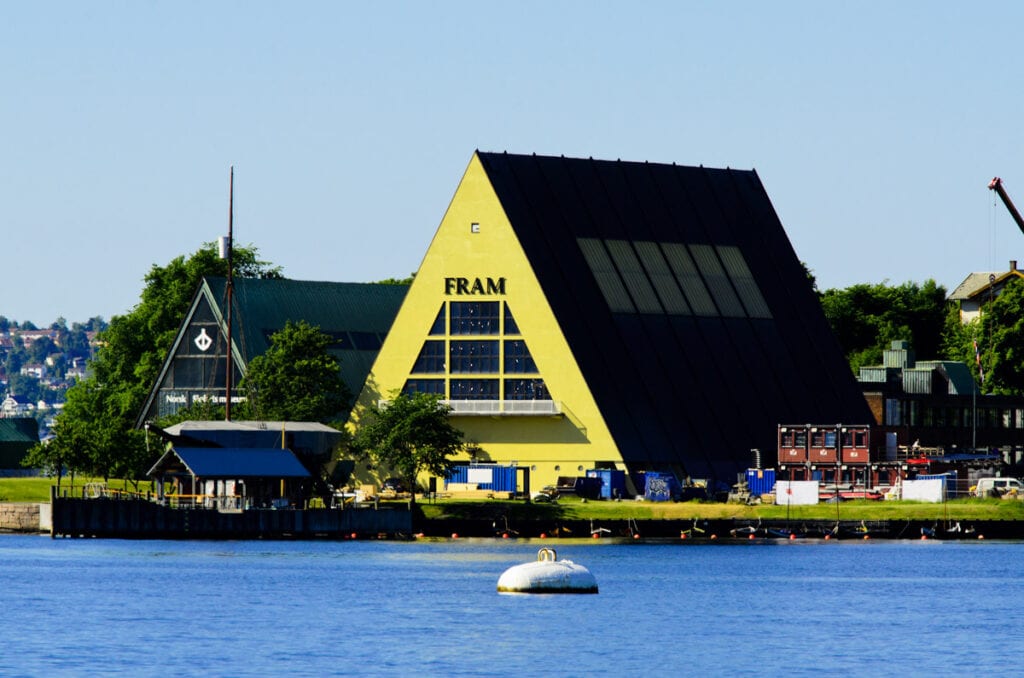
Today the museum hosts surround film from the deck of the ship. You can board the ship and walk the deck, and peek into the cabins and the engine room.
The museum boasts many other exhibits, of course, documenting many famous polar voyages. A connected building holds the Gjøa, the ship that first navigated the Northwest Passage.
The museum is open everyday, year round. Visit the museum website for information on hours and entrance fees. You can also buy tickets online at Viator.
Looking for a guided one day sightseeing experience? Check out this city coach tour, which includes Vigeland Park, the Fram Museum, the Norsk Folkemuseum and more, along with a sightseeing cruise.
Check price and availability on a one day Oslo sightseeing tour now!
9. Or Cruise the Oslo Fjord
If you aren’t into museums, or you want to spend your time outdoors, consider a cruise of the scenic Oslo Fjord!
This well-reviewed 2-hour Oslo Fjord sightseeing cruise comes with commentary on Oslo and the nature and countryside surrounding the city.
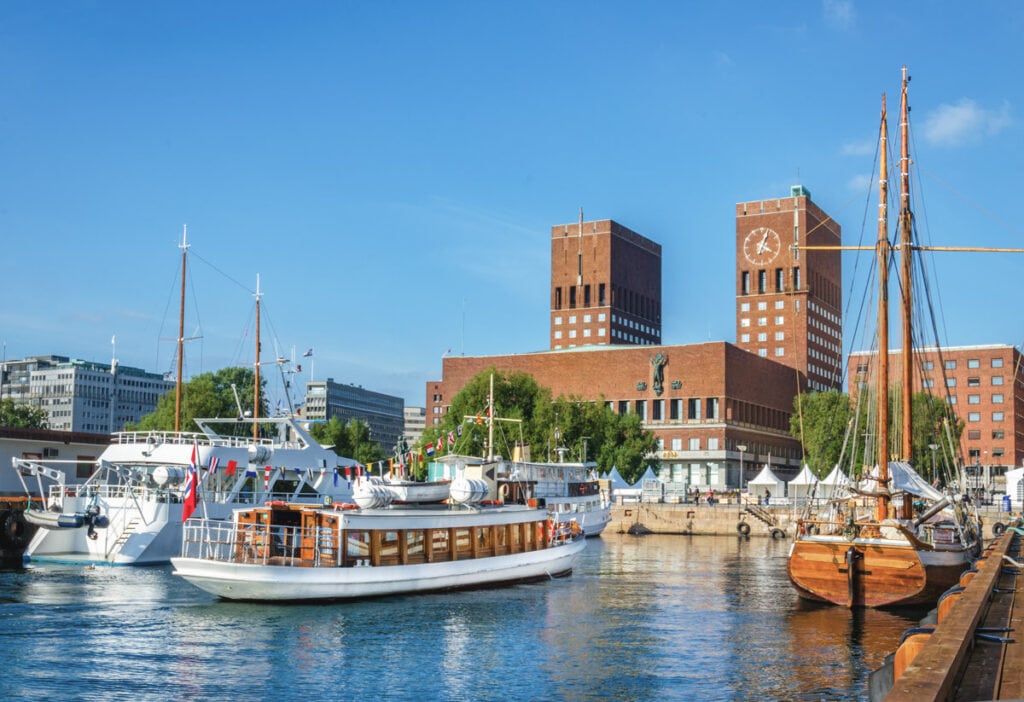
As you cruise the tranquil waters, enjoy views of Oslo’s picturesque waterfront, and the forested hills around the city.
You’ll sail past many small islands and the Dyna Lighthouse, and weave your way into through narrow inlets and sheltered bays for the best photo ops. You will also pass the iconic Opera House in Oslo, so you’ll be able to snap photos of it from the water!
The cruise departs from the pier opposite the City Hall. There are several departure times, so you can fit it into your itinerary where it works best for you.
Check price and availability on a sightseeing cruise of Oslo Fjord now!
10. Peek into the Past at Akershus Castle and Fortress
One of the best things to do on your one day in Oslo is a visit to historic Akershus Castle and Fortress.
Overlooking the Oslo Fjord, the Akershus Fortress dates back to the late 1200s and early 1300s and was built to protect the city. It has, in fact, successfully withstood several sieges!
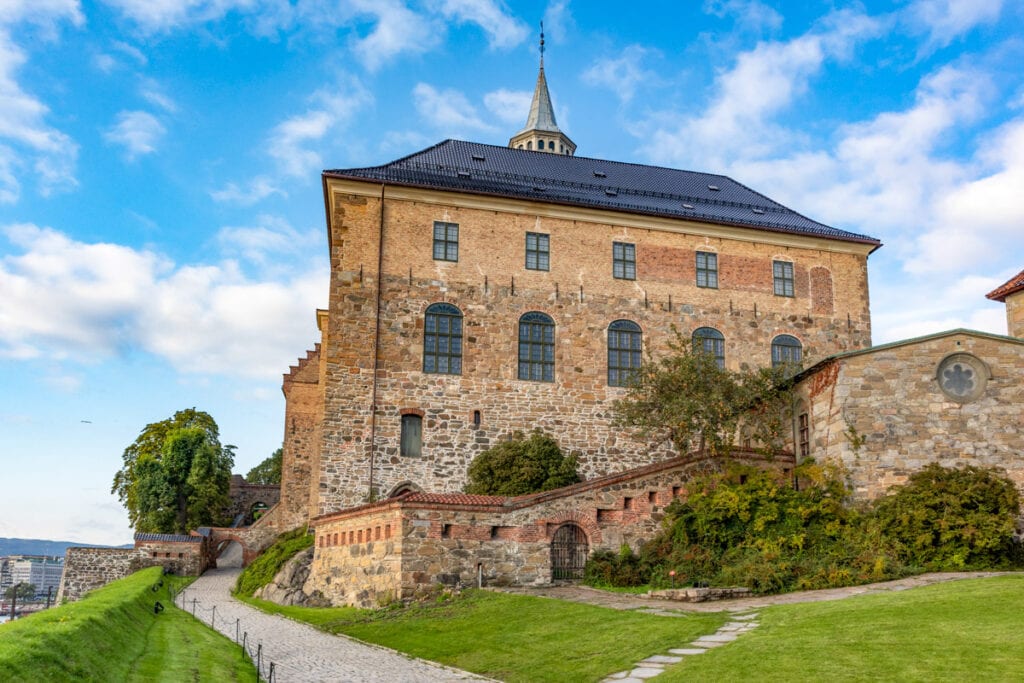
Originally designed as a medieval castle, Akershus Fortress was later renovated by King Christian IV so he could use it as a royal residence. The castle was modernized to give it a more Renaissance-style look in line with the times.
Over time, the castle-palace was further modified and expanded.
Akershus surrendered without fighting to Nazi forces in 1940. It was liberated in 1945, following which a number of Norwegian traitors were executed here, including Vikdun Quisling.
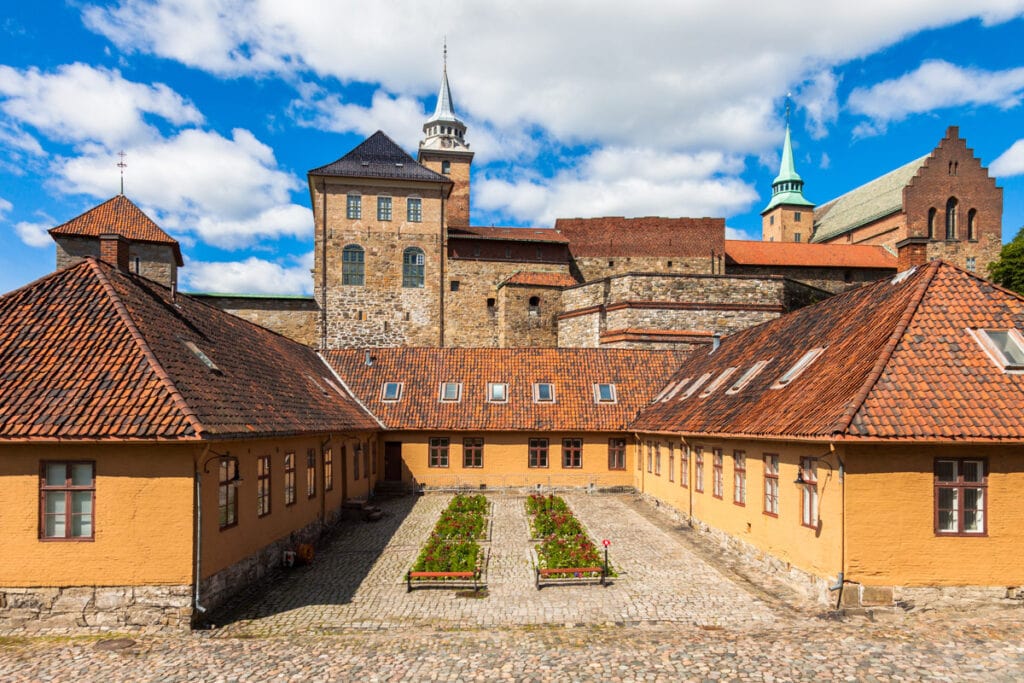
Today, the fortress is still used as a military area but the public can visit on a guided tour. Along with the castle, you can visit the WW2 Resistance Museum and the Armed Forces Museum, which are housed here.
Akershus offers excellent views of Oslo Harbor. The grounds make for great wandering, and sometimes concerts and other events are hosted here.
Akershus Castle is open everyday from 6 a.m. (7 a.m. from October through April) until 9 p.m. The visitor center, museums, and eateries may have different hours of operation and some may be closed in the winter.
The grounds are free to enter but guided tours of the castle and museums have a fee.
11. Enjoy the ambience at Aker Brygge
Spend the evening of your one day in Oslo at Aker Brygge!
The harbor-front area is one of the most popular spots in Oslo, and with its charming promenade, it’s not hard to see why!
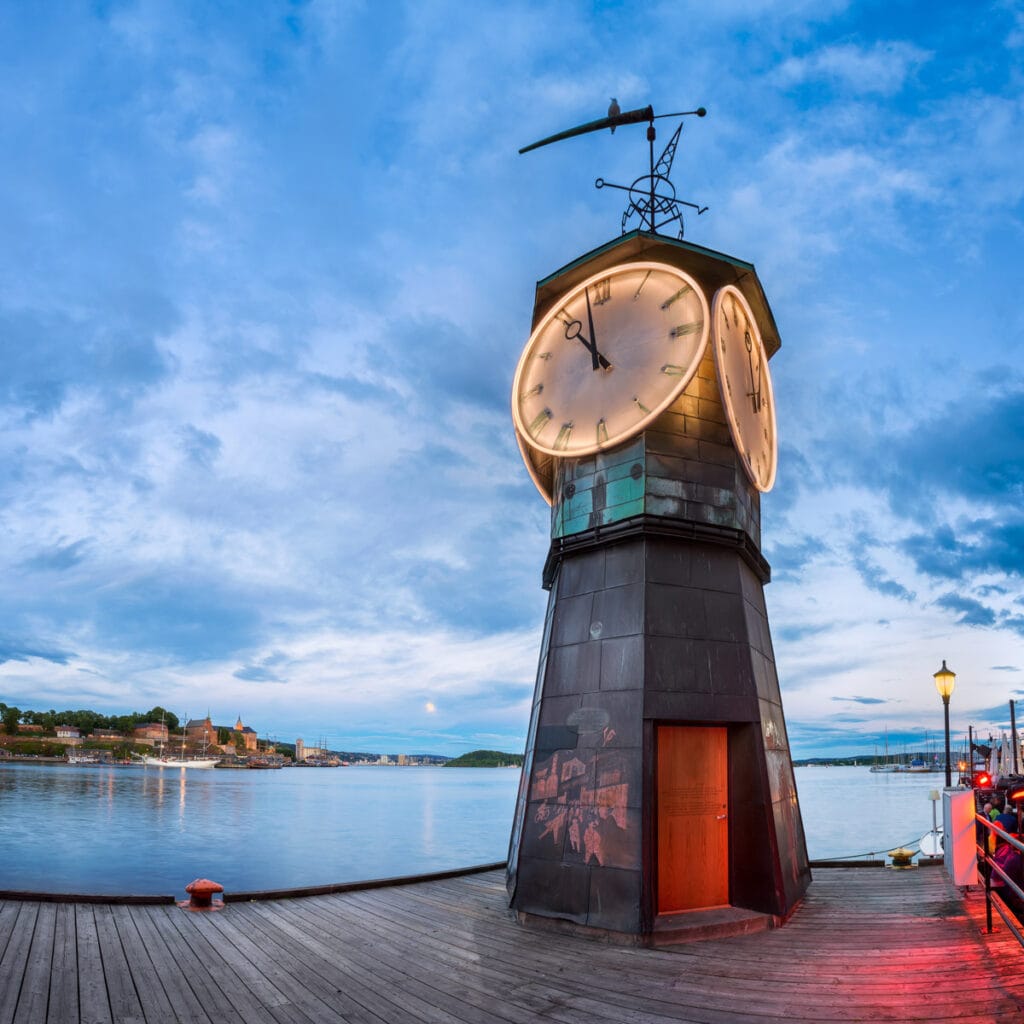
An industrial area and shipyard in the 1800s, the neighborhood underwent a renovation in the late 1990s. The stark contrast between the old shipyard buildings and the modern architecture creates a really dynamic feel.
Aker Brygge is home to dozens of shops, bars, and restaurants, so there are endless opportunities for shopping and dining.
Many of the eateries are located along the seafront boardwalk, so you’ll be treated to scenic views whilst you dine. On a nice weather evening, you’ll definitely want to dine al fresco!
Architecture and design enthusiasts must also cross the bridge to Tjuvholmen, where you will find art installations scattered amidst the houses. There’s plenty of architecture to admire, and numerous art galleries to visit.
Be sure to snap a photo of the stunning Astrup Fearnley Museum of Contemporary Art!
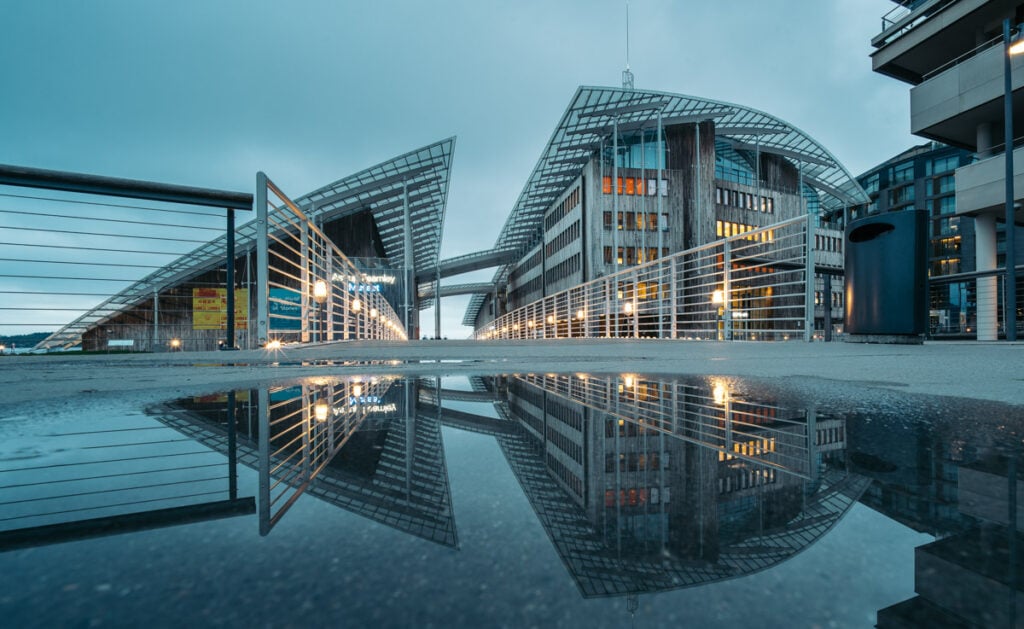
Tjuvholmen is also known for its dining scene and both Aker Brygge and Tjuvholmen for their nightlife. Stop in at Lektern for a drink! The unique bar is set on a pontoon on the fjord.
With More Time in Oslo
Planning to spend more than one day in Oslo? There are other Oslo activities you can add to your itinerary, or you can swap some of these Oslo attractions for the ones we’ve described above, based on your interests.
Visit the Kon-Tiki Museum
The Kon-Tiki Museum was established in 1947, after Norwegian explorer Thor Heyerdahl’s mind-boggling expedition across the Pacific Ocean in the balsawood raft called Kon-Tiki.
A documentary made on the expedition won an Academy Award in 1951, and can be seen when you visit, along with exhibits of the vessels Heyerdahl used on his many expeditions.
The museum, located in the Bygdøy peninsula, is fascinating for kids and adults alike!
Get visiting hours and fees on the museum website.
See the Ski Jump at Holmenkollen
Outdoor enthusiasts will want to head out to Holmenkollen, known for being the site of many international winter sports competitions.
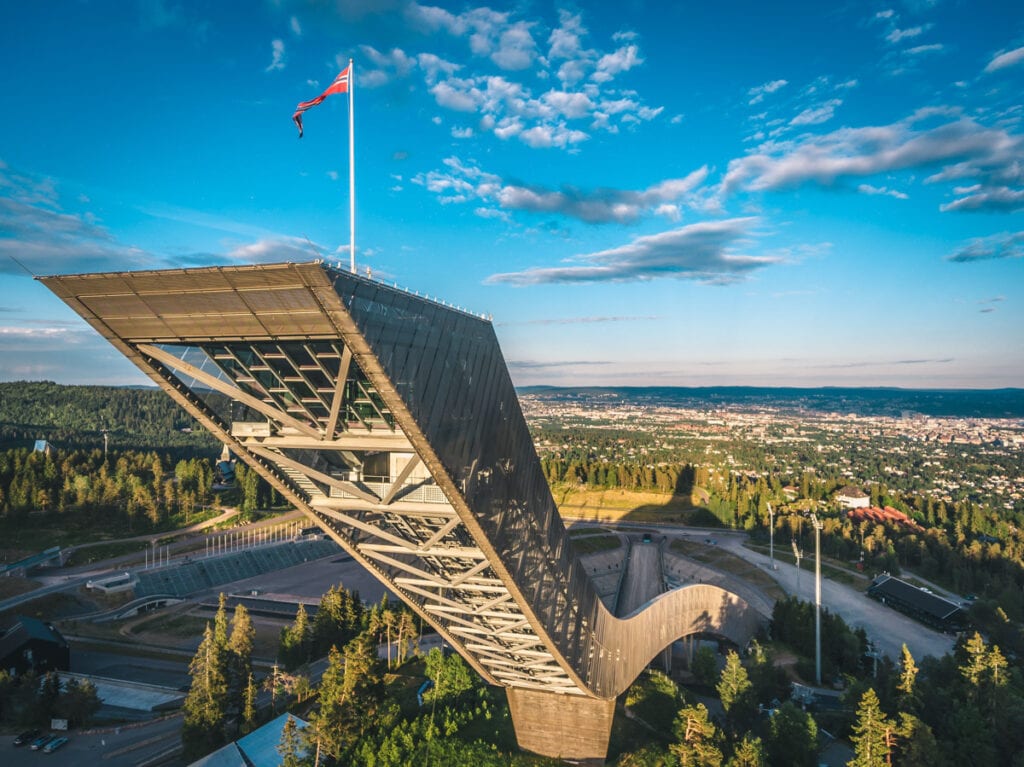
Enjoy the Holmenkollen Ski Museum, and take in the views from the tower! You can also experience the ski simulator if you want to know what it feels like to jump from the top,or play frisbee golf.
And adventurous visitors can zipline down the mountain.
Good to know: The Ski Museum is closed for renovation until the end of 2023, but the viewpoint is still open!
Admire Art at MUNCH!
MUNCH, an art museum that showcases Edvard Munch’s art, is located in a striking new building along Oslo’s waterfront since 2021.
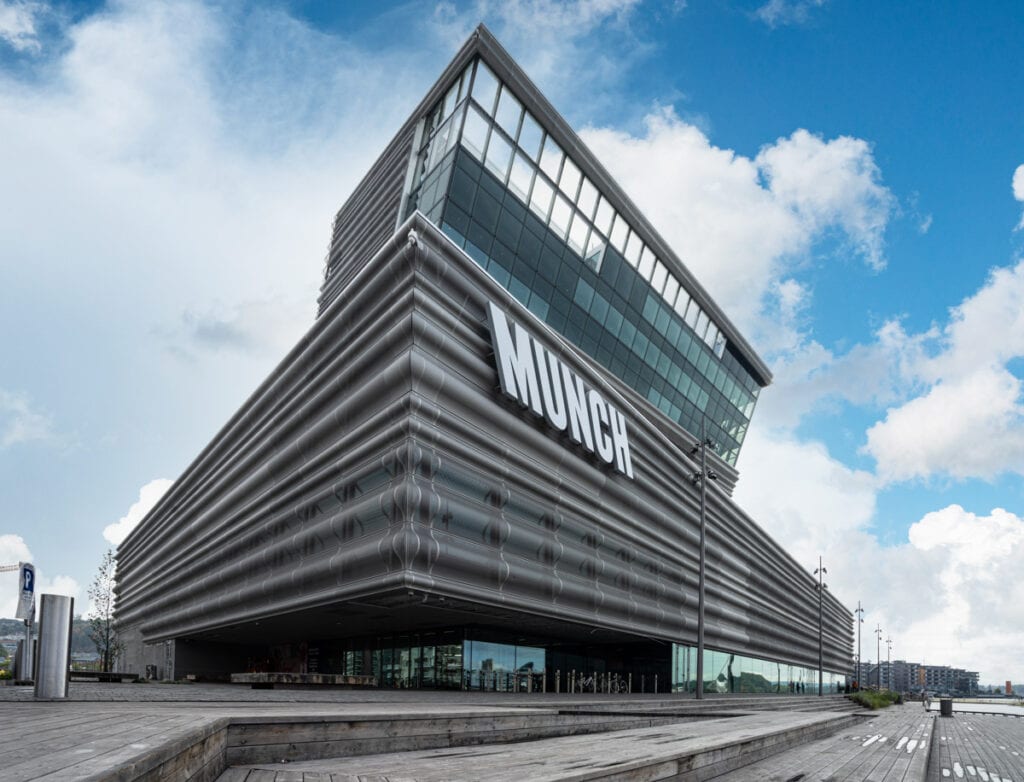
Spread across 11 galleries, the museum also features exhibitions by other modern and contemporary artists. Some of Munch’s large works are displayed in a double-height gallery.
The museum features a bar on the top level and a restaurant on the level just below, both of which offer fabulous views of the water.
Cruise the Oslo Fjord on a Wooden Sailing Boat
This highly-rated leisurely sail around the waters of the Oslo Fjord is a relaxing way to spend an evening. The cruise lasts 3 hours and includes a snack of Norwegian shrimp.
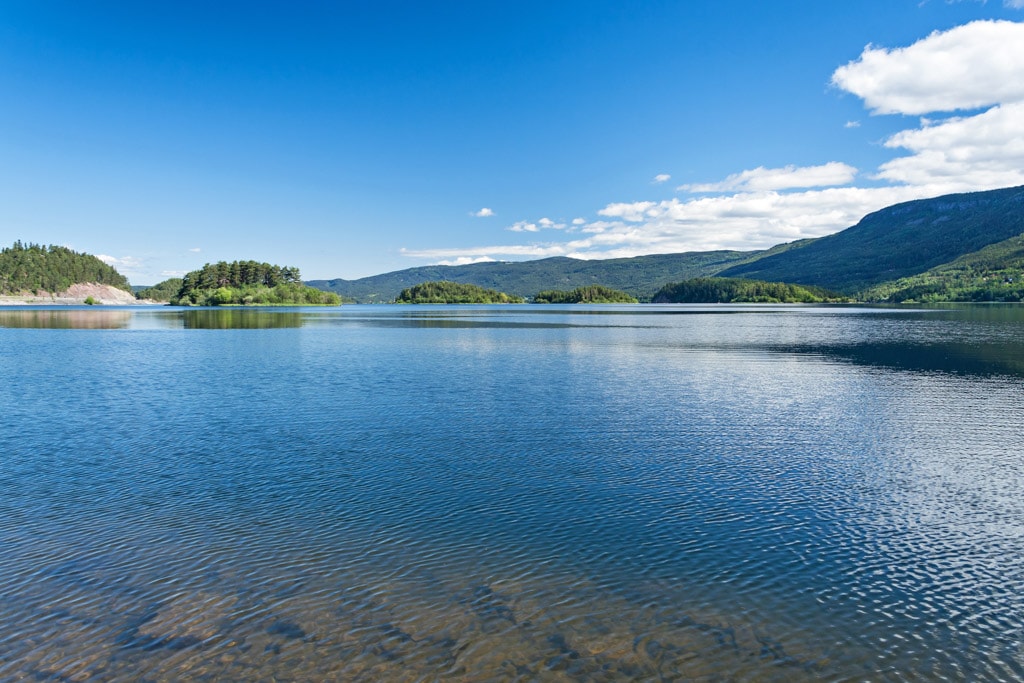
You’ll sail past the Akershus Fortress, the Oslo Opera House, and the islets in the fjord as the sun goes down, making for a magical experience.
The boat tour departs from Rådhusbrygge 3, the pier near City Hall. Dress warm!
Check price and availability on this 3-hour Oslo Fjord cruise now!
Getting into oslo
Oslo Gardermoen Airport is the international airport that serves Oslo. You can fly into airport from other parts of Europe and many other international destinations.
The airport is located about 50 kilometers (about 31 miles) northeast of the Oslo city center, and there are several ways to travel into the city.
The Flytoget Airport express train runs frequently between the airport and the Oslo Central Station, and the journey takes 20 minutes. Regular Vy trains also run between the airport and Oslo Central Station.
Flybussen is the bus service that connects the airport with the city center and surrounding areas. The journey time is about 45-50 minutes.
You’ll also find taxis at the airport. Oslo Taxi, and some other companies, offer fixed fares, so ask for the price ahead of the journey. The travel time is about 40 minutes.
You can also book a transfer in advance, to get an English-speaking driver and flight delay monitoring.
If you are traveling into Oslo by train (from Stockholm, Bergen, or Flam, for example), you’ll arrive at Oslo Central Station, located in the heart of the city center. From the station, you can take a taxi to your hotel if you wish.
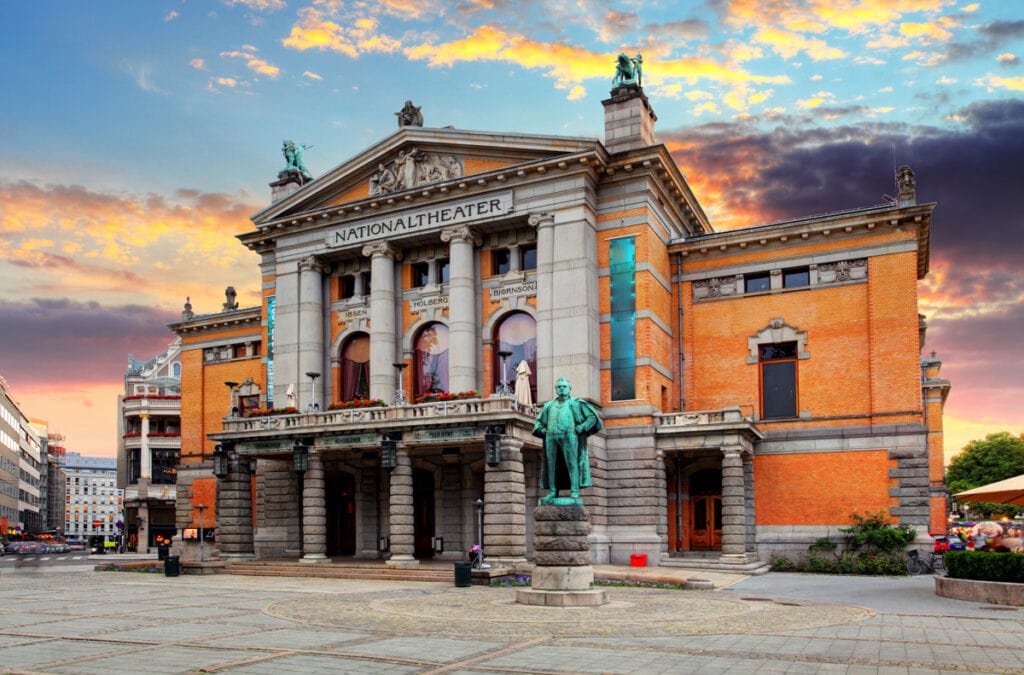
Getting Around in Oslo
Oslo is compact enough that you can walk (or bike!) around to many sights within the heart of the city center.
But if you do not wish to walk, or to get to places further away, Oslo also has the super efficient public transport system, Ruter, with linked ticketing (except for the ferries between the center and the Bygdoy museums).
Get the Ruter app to check schedules and buy tickets.
Public transport options include buses, trams, local trains, ferries, and the underground.
If you get the Oslo Pass, travel within zones 1 and 2 are included (Oslo is zone 1). Ferries to Bygdøy are also included in the Oslo Pass.
Oslo also has Hop On, Hop Off buses (with a 24-hour option) that stop at various major sights and come with on-board commentary. The sightseeing bus is a great way to get an overview of the city, or to get from sight to sight if the weather doesn’t cooperate!
Check prices and availability for the Oslo Hop On, Hop Off bus now!

Where to Stay in Oslo
With just 24 hours in Oslo, you’ll want to stay in the city center.
Thon Hotel Opera is located in the heart of Oslo, convenient for sightseeing and dining. The hotel offers spacious contemporary rooms and well-appointed bathrooms with heated floors.
The onsite restaurant, Scala, serves Norwegian cuisine, and the buffet breakfasts, with numerous choices, are highly rated.
Clarion Hotel Oslo is located in the lively Barcode district in the city center, close to the Oslo Opera House and the Munch Museum. Rooms feature modern furnishings and the spacious bathrooms are well-appointed.
Breakfasts feature large spreads and are highly rated. You’ll find several restaurants within walking distance.
Radisson Blu Plaza Hotel is a high-rise hotel in the city center, walking distance to major attractions as well as shopping and dining. Rooms feature fabulous views of the city center.
Dine on traditional Norwegian cuisine at the Top Restaurant and Bar, where tall glass windows bring in the views. The breakfast buffet offers lots of choices.
Check prices and availability for the Radisson Blu Plaza Hotel now!
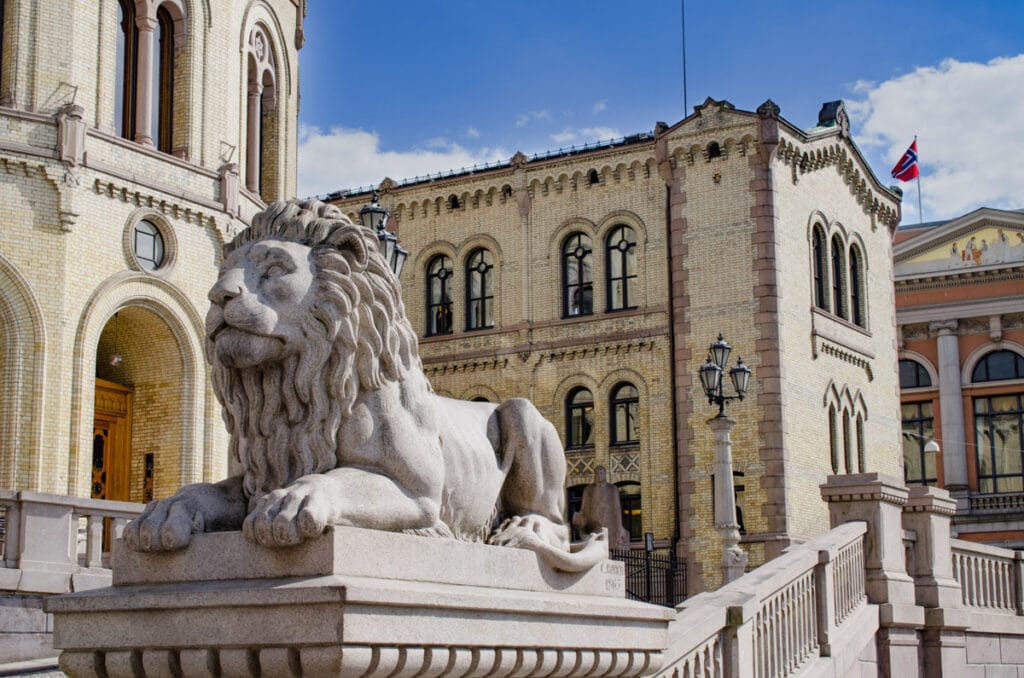
Where to Eat in Oslo
For lunch, head to Gamle Raadhus, located near the Akershus Fortress. The restaurant serves Norwegian cuisine, with lots of fish dishes on the menu.
Or eat at Grilleriet, which features an open kitchen. Many dishes are made on a charcoal grill, hence the name. The restaurant uses fresh seasonal ingredients with exotic spices to craft flavorful creations.
Near the Munch Museum, the Grand Cafe is a great place for coffee or a glass of wine. W. B. Samson along Karl Johans Gate is another fun place to stop for a coffee and a pastry.
For dinner, try Tjuvholmen Sjømagasin for a menu inspired by local seafood and seasonal vegetables. The restaurant features large windows that allow you to soak in the views and the lively ambience outside as you dine.
Another great seafood restaurant in Aker Brygge is Lofoten Fish Restaurant. Be warned, though, the menu is heavily seafood centric and there aren’t any vegetarian options.
Delicatessen Aker Brygge offers a Spanish-inspired menu, with plenty of vegetarian options. The ambience is lively and the tapas perfection.
Be sure to make reservations for dinner ahead of your visit to get a good table at the time you wish to dine.
The Best Time to Visit Oslo
Late spring (May or June) is a wonderful time to visit Oslo. Daytime temperatures are in the 60s Fahrenheit, perfect for exploring outside (but bring a light but warm jacket for breezy days and for early and late in the day).
While summer and early fall bring warmer temperatures and long daylight hours, you are also likely to run into wet weather at this time of the year, so be sure to pack rain gear.
For festival lovers, Oslo hosts a number of festivals in September, from opera and contemporary music to the Ibsen Festival, when plays are held at the National Theatre.
Winters in Oslo are frigid. While the city looks stunning in the winter, remember that daylight hours are quite short, and pack for temperatures in the 20s and 30s Fahrenheit. Winter sports enthusiasts will find great opportunities in Holmenkollen.
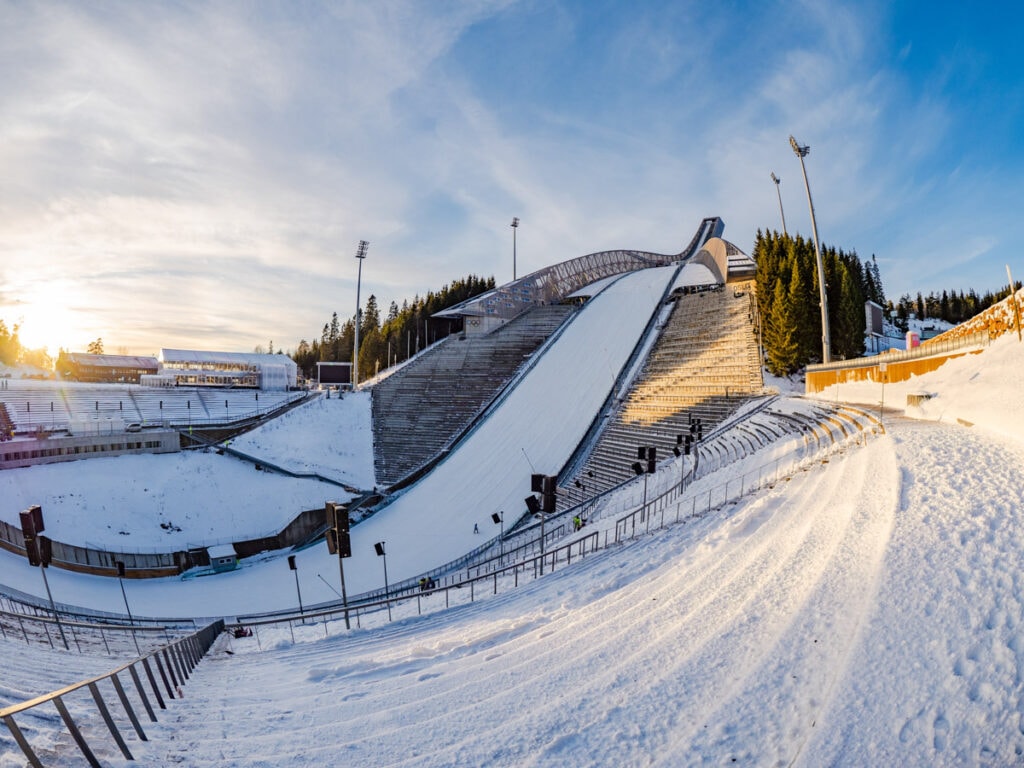
The Oslo Pass
Available as a 24, 48, or 72 hour card, the Oslo Pass may save you money (and time!), especially if you have several museums or attractions with entrance fees on your itinerary.
The pass includes many major attractions, such as Akershus Fortress and Castle, the National Museum, the Fram Museum, the MUNCH Museum, and the Norsk Folkemuseum. There are 30 attractions on the pass.
The Oslo Pass also comes with unlimited use of Oslo public transport during your stay.
More Scandinavia Travel Inspiration
Planning a trip to Scandinavia? Check out our 10-day Scandinavia itinerary that covers Copenhagen, Stockholm, and Oslo, plus some of the most scenic countryside in Norway.
If you are going to explore more of Norway, we have a comprehensive guide to one day in Bergen. In Bergen, be sure to take the Floibanen funicular to the top of Mt. Floyen! We also have an article on the best things to do in Stavanger, which is close to the famous Pulpit Rock.
We also have an in-depth guide to one day in Copenhagen, as well as the best day trips from Copenhagen.
And be sure to check out our articles on Stockholm, where we have spent quite a bit of time. Discover how to visit Drottningholm Palace, how to take a self-guided tour of Stockholm subway art, and how to visit the UNESCO site of Skogskyrkogarden.
We also have a one-day itinerary for Stockholm, as well as a round-up of the best things to do in Stockholm!
And if you are planning a quick visit to Helsinki, the Finnish capital, from Stockholm, we have a one day in Helsinki itinerary you must read!
Did you find this article informative? Pin it for later reference!
